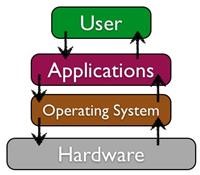Table of Contents |
An operating system (OS) is software that performs the task required to keep the system running, and provides the main interface for the user. In essence, the operating system enables the computer’s hardware to communicate with and control the computer’s software, while providing the user with a way to interact with both. All computing devices (desktop PCs, notebook PCs, tablet PCs, smartphones, etc.) run an operating system. Without the operating system, a computer would not be operational. The operating system orchestrates several essential functions, including managing the hardware resources of the computer, providing the user-interface components, and providing a platform for software developers to write applications. The user-interface is what allows a user to interact with the files and software on a computer. Typically, when a computer is in operation, multiple programs are running concurrently. All software running must have access to the computer’s resources, such as CPU, memory, and storage, in order to function properly. The operating system is what coordinates access to the hardware (CPU, memory, and storage) to ensure that each software application gets the resources it needs.

Operating systems facilitate communication between the user and the computer’s resources. When a user interacts with applications, the operating system manages access to the computer's resources, such as CPU, memory and storage, and peripheral devices.
In most cases, when you purchase a computer, it will come loaded with an operating system on it. Most people use the operating system that comes with the computer. For personal computers, the most popular operating systems are Microsoft’s Windows, Apple’s OS X, and different versions of Linux. These standard operating systems are typically only found on desktop or laptop computers. Mobile operating systems such as Apple’s iOS, Google’s Android, Microsoft’s Windows Mobile, and Blackberry are run on smartphones and tablets.
Operating systems can be differentiated from one another by characteristics such as: if it offers a graphical user interface (GUI), if it can multitask, if it is multi-user, and if it is commercial or open-source. We will examine these characteristics in more detail below.
Early personal-computer operating systems were simple by today’s standards. For example, they did not provide multitasking and required the user to type commands to initiate an action. However, as computers have evolved, so have the characteristics of their operating systems.
Early computers were difficult to program and required great attention to detail. However, many personal-computer enthusiasts immediately banded together to build applications and solve problems. These computer enthusiasts were happy to share any programs they built, as well as any solutions to problems they found. This collaboration enabled them to more quickly innovate and fix problems. Open-source software is free software that makes the source code available for anyone to copy and use. This encourages others to contribute to the future development and improvement of the software. The open-source movement has led to the development of some of the most-used software in the world, including the Firefox browser, the Linux operating system, the Apache web server, FreeBSD, and GNU.
However, as software began to become a business, this idea of sharing everything fell out of favor, at least with some. This led to a new business model of restrictive software licensing, which required payment for software, a model that is still dominant today. This model is sometimes referred to as commercial (closed-source), as the source code is not made available to others. Examples of commercial operating systems are Microsoft Windows and Apple OSX.
There are many arguments on both sides of the aisle for the commercial or open-source software. The table below explains some benefits for open-source and closed-source operating systems.
| Operating System | Benefits |
|---|---|
| Open-Source |
The software is available for free. The software source-code is available; it can be examined and reviewed before it is installed. The large community of programmers who work on open-source projects leads to quick bug-fixing and feature additions. |
| Commercial (Closed-Source) |
By providing financial incentive for software development, some of the brightest minds have chosen software development as a career. Technical support from the company that developed the software. |
The table below lists today’s common operating systems, and summarizes their user interface, multitasking, and multi-user characteristics.
| Operating System | User Interface | Multitasking | Multi-user | Open-Source Or Commercial |
|---|---|---|---|---|
| MS Windows | GUI/Command Line | Yes | No | Commercial |
| Linux | GUI/Command Line | Yes | Yes | Open-Source |
| UNIX | GUI/Command Line | Yes | Yes | Commercial |
| Mac OS | GUI | Yes | No | Commercial |
| MS DOS | Command Line | No | No | Commercial |
| Windows Mobile | GUI | No | No | Commercial |
| Apple iOS | GUI | No | No | Commercial |
| Android | GUI | Yes (up to two applications at once) | No | Commercial |
Source: Derived from Chapter 3 of “Information Systems for Business and Beyond” by David T. Bourgeois. Some sections removed for brevity. https://www.saylor.org/site/textbooks/Information%20Systems%20for%20Business%20and%20Beyond/Textbook.html